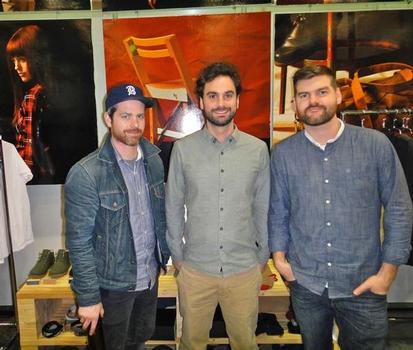Lifetime caught my eye at Know?Show because the styling was a bit older and more fashion forward then other action sports lifestyle companies I saw at the show and at Agenda.
I got a chance to talk to founders Trevor Fleming and Reid Stewart as well as General Manager Nick Brown while in Vancouver.
In 2000, Trevor and Reid met snowboarding. Trevor was working for a dot com in Santa Cruz and Reid was at school, doing graphics on the side. As high schoolers, when not spending time skateboarding or snowboarding, the two made a line of silkscreened tees and hoodies.
 In 2002, Trevor lost his job and moved back to Canada. He connected with Reid and they decided to go into business and launched their first cut and sew collection that year.
In 2002, Trevor lost his job and moved back to Canada. He connected with Reid and they decided to go into business and launched their first cut and sew collection that year.
The name Lifetime stands for timeless … everything they were doing and the lifestyles they were living.
The brand started as a graphics driven company in the early 2000s, heavily influenced by 80s skateboard designs. As they grew older and progressed, the line evolved.
“Now it’s a fashion brand with roots in skating and snowboarding. We work with a collective of artists, musicians, and athletes,” said Reid, who noted the brand often holds concerts in its warehouse.
The company is currently based in Canada with six employees working out of the head office. They also have an in-house sales rep doing U.S. sales based in Seattle. Nick helps with U.S. sales as well.
Today, the brand concentrates on fashion pieces ranging from jackets and sweaters to button-ups, plaids and wovens.
They sell to core shops and boutiques. In North America, they have over 200 doors, mostly boutiques and core shops.
 The Canada market for Lifetime is about twice the size as it is in the USA and is divided 50/50 between core shops and boutiques since they started the line in snowboard and skateboard stores.
The Canada market for Lifetime is about twice the size as it is in the USA and is divided 50/50 between core shops and boutiques since they started the line in snowboard and skateboard stores.
They launched in the U.S. later so picked up more of a boutique following in the states since the line was more evolved into higher fashion by that point.
They also have distributors in Japan, Australia, New Zealand, Sweden, Germany and Switzerland.
The brand is divided 65% men, 35% women and for Spring 2012, they hired a female designer to focus on women’s for the first time.
In talking with Trevor and Reid, they said their goal for the brand was to be able to appeal to both the core and boutique market. While this year’s line is based around workwear and old rock and roll, they said they see a huge potential for more fashion forward pieces within the action sports segment.
“All those kids who were wearing tees 15 years ago, now want to wear a button up,” said Trevor.






